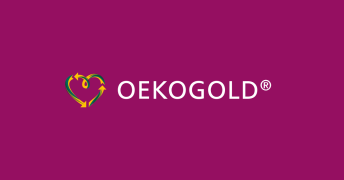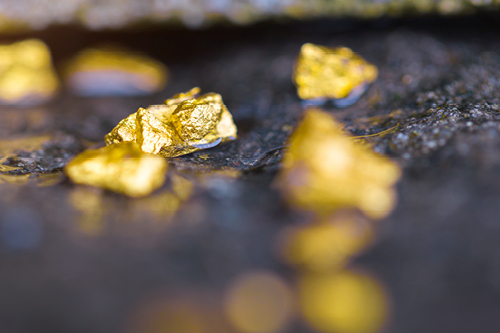These days, gold is not just gold. Anyone who processes gold or buys gold is confronted with the extremely diverse concepts. Consumer awareness of ethically and ecologically sound gold is increasing in the jewellery and investment industry. More and more bridal couples, for example, attach importance to selecting their wedding rings not only according to the design but also according to the origin of the gold.
This also brings with it an increasing number of seals of approval and labels. If you feel that you have lost track of things,, the following article is just right for you.
What is actually meant by sustainable gold?
Unfortunately, the term „sustainability“ has become a rubber word as everyone defines it differently. However, if one takes a closer look at its meaning, the explanation in the dictionary is the most appropriate: sustainability describes the principle according to which no more may be consumed than can grow back, regenerate and be made available again in the future.
In terms of gold, this means conserving resources before new production and recycling resources that are already in circulation.
It is unfortunately a fact that gold is not always extracted in a sustainable manner. Among the dramatic problems in the extraction of mining gold are environmental destruction, child labour, violation of human rights and financing of terrorist groups. In order to counteract these problems, the OECD has drawn up guidelines for the extraction of conflict-free precious metal, which are implemented in standards and certified by independent institutes such as the LBMA (London Bullion Market Association) and the RJC (Responsible Jewellery Council). In addition, there are a variety of seals of approval that also focus on the sustainability of gold.
The three main sources of gold
In order to get a better overview of different labels and quality seals, it is important to distinguish between the different sources of supply. These include industrial mining, small-scale mining and recycling.
– Industrial mining: With 2,500 to 3,000 tonnes of gold, i.e. around 80% of the world’s primary gold production, comes from industrial mining.
– Small-scale mining: According to the OECD, small-scale mining includes formal or informal operations with primarily simplified forms of raw material exploration and extraction, processing and transport. Small-scale mining can employ individuals, families or companies with typically fewer than 50 people. Approximately 20% of primary gold production, or about 330 tonnes of gold, is extracted annually.
– Recycling: About 27% of the total annual gold demand is covered by recycled gold. In Germany, gold and silver refineries process gold from electronic scrap and valuable old gold such as jewellery or dental gold for recycling, with the aim of fully exploiting the gold already present in the material cycle.
More information on the three gold sources listed above can be found in the current market study for responsible gold from small-scale mining by the Federal Institute for Geosciences and Natural Resources.
An overview of the most well-known seals of approval and labels
Currently, various seals of approval and labels are represented in the gold market. They prescribe certain social and ecological requirements for gold extraction. The most common ones are listed below according to the source of extraction.

- Small-scale mining: Fairtrade Gold
The Fairtrade seal is probably the best-known seal for fairly traded products from various industries from coffee to sports balls. The Fairtrade Labelling Organizations International (FLO) is responsible for the Fairtrade Gold product label.
Fairtrade is applicable for the ASM (Artisanal Small Mining). The mines are operated by small groups and families in cooperatives, which share the yield among themselves „fairly“. This programme aims to prevent exploitation and to improve and maintain the infrastructure. In addition, the Fairtrade Gold Standard excludes trade in gold from conflict areas. Guidelines for dealing with the environment are also laid down.
Fairtrade gold costs comparatively more than conventionally mined gold. If you want to process it, it is strictly prohibited to add other gold.
Other well-known seals of quality in small-scale mining include Fairmined Gold and Alliance for Responsible Mining.

- Industrial mining: Green Gold
While Fairtrade Gold has a label right in front of your eyes, with „Green Gold“ it could be a little more difficult to assign the appropriate seal of approval. This is because many do not perceive „Green Gold“ as a brand but rather as a general term for ecologically sound gold. The Swiss refinery Valcambi markets its gold bars under the „Green Gold“ label. Valcambi explains that the gold for the bars comes exclusively from certified gold mines in compliance with human rights and environmental protection standards.

- Recycling: OEKOGOLD
The term OEKOGOLD, like green gold, is also very often generally used for sustainable gold. There is no seal of approval for this. Swiss goldsmiths and jewellers who do not use primary gold in their jewellery have joined forces under the Oekogold label, i.e. they only purchase semi-finished precious metal products made of recycled gold from gold and silver refineries certified by the Responsible Jewellery Council (RJC) in London.
Development towards more sustainable gold …
For the largest sporting event in 2020 – the Olympic Games, Japan announced that it will produce the 5,000 or so medals needed exclusively from recycled precious metals recovered from collected electronic waste. It is one of the first signs of how we should handle our raw materials in the future. In our opinion, recycled gold is the prime example of resource efficiency and closed loop recycling management.
This is also confirmed by the results of a study by the Pforzheim University of Applied Sciences (Institute for Industrial Ecology-INEC) on the carbon footprint of gold extraction. According to this study, the climate footprint of recycled gold from scrap gold is around 53 kg CO2 per kilogram of gold. However, when gold is extracted from mines, the carbon footprint is 11,500 kg and 55,000 kg – up to 1,000 times more.
So it depends a lot on where the gold comes from. If it can be proven that the gold does not originate from primary extraction or a dubious gold washing process, its ecological balance sheet improves dramatically. Nowadays, certified gold and silver refineries are obliged to check the delivered gold for its origin and thus exclude primary gold from the outset.
Many gold processors are now faced with the big question, which gold do I purchase now? And how do I communicate with my end customer about it? Some goldsmiths will certainly wonder why people suddenly focus on recycling gold as sustainable gold when they have always processed it anyway.
We believe that the jewellery market is ready for a change to sustainable gold, and that we must seize the opportunity now to communicate this to end customers because it is not only a question of where the gold for one’s jewellery comes from, but also how I can recycle one’s old jewellery.
Some major jewellery manufacturers are already addressing this issue in their campaigns. Major trade fairs such as Inhorgenta are putting the theme of „sustainability“ 2020 at the heart of their supporting program.
This means that the first steps are already being taken and we are looking forward to the future together!
